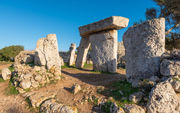
MENORCA TALAYÓTICA
The list of properties that in September 2023 has been included as a UNESCO World Heritage Site is made up of archaeological sites representative of the Menorcan Talayotic Culture, which best illustrate the Prehistory and Protohistory of the island of Menorca. They represent the different construction typologies and those of the highest monumental quality, as well as for being the best scientifically researched monuments and for their contribution to the knowledge of said culture in its different manifestations: from the socio-economic aspects to its territorial organization and its funerary rituals or festivities.
Menorca has exceptional heritage, reflected in the 1,574 archaeological sites inventoried on its 700 km2 surface. They are sites of very different monumental categories and cover a wide chronological range, from the arrival of man to the island to the Islamic medieval period. Of them, 1,401 have the protection category as Assets of Cultural Interest, the maximum legal protection of the heritage legislation provided for in the Spanish State.
The name Talayotic culture is related to one of the typical elements of this culture, tower-shaped buildings known to the inhabitants of the island as talayots. From the 19th century to the present day, scientific literature uses that name as a generic title for a broad period of island prehistory.
The Prehistory of Menorca covers a long chronological period that begins with the arrival of man to the island and ends with the Roman conquest, which occurred in 123 BC. C. The finds of lithic industry at Binimel·là point to a pre-Neolithic occupation around 6000 BC; However, the scientific data that corroborates the presence of permanent human communities must be between 2500 and 2100 BC. thanks to the radiocarbon dating carried out on the remains of the burials from the Biniai Nou tomb. These are communities halfway between the Chalcolithic and the early Bronze Age, which were established in the main ecological niches and in the most fertile areas of the island.
These archaeological sites have been selected for a series of reasons, such as their good state of conservation or the fact that archaeological research has been carried out there; but especially because among the total number of buildings identified, each of the serial and typified architectural elements of the Talayotic Culture and its predecessors are represented.
Their characteristics, both due to the construction technique used, Cyclopean dry stone, without mortar, and the resulting shape of each one, make them megaliths of great singularity and unique in the World Heritage.
These are the sites that make up the Talayotic World Heritage of Menorca:
Calascoves - Cornia Nou - Cova des Pas - Galliner de Madona - Naveta den Tudons - Rafal Rubi - Sant Agustí
Ses Roques Llises - So Na Caçana - Son Catlar - Son Mercer de Baix - Talati de Dalt - Torelló
Torralba den Salord - Torre den Galmés - Torrellafuda - Torretrenada - Trepucó








